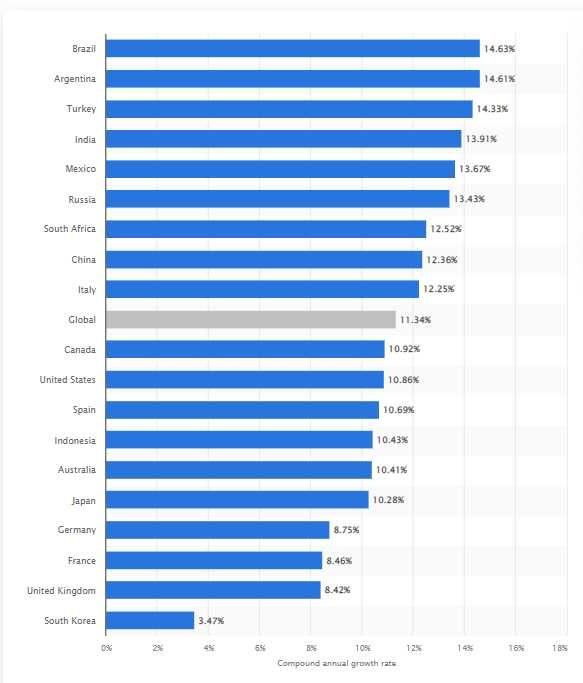Introduction
EDI in eCommerce facilitates the exchange of business documents, such as purchase orders, invoices, and shipping notices, between trading partners and customers in a standardized format.

Define eCommerce
E-commerce stands for electronic commerce. It makes buying and selling products or services easy by using the internet. It makes use of various digital technologies such as websites, mobile apps, and social media to process online transactions between buyers and sellers.
E-commerce stores help customers browse through products and facilitate the purchase of products or services using electronic payment methods such as credit cards, debit cards, e-wallets/digital wallets, and bank transfers.
The advent of e-commerce has transformed the business landscape and has presented new opportunities for entrepreneurs and consumers alike to reach global marketplaces.
Key Takeaways
- EDI in eCommerce streamlines the exchange of business documents like orders, invoices, and inventory updates between trading partners.
- It automates processes, reducing manual errors and speeding up order fulfillment.
- EDI ensures accurate inventory management, helping eCommerce businesses meet customer expectations.
- By integrating EDI with eCommerce platforms, businesses can enhance scalability and handle high transaction volumes efficiently.
- EDI fosters stronger relationships with trading partners by ensuring compliance and seamless communication.
Interesting EDI and eCommerce Stats
Here are some statistics that illustrate how Electronic Data Interchange (EDI) is helping the e-commerce industry:
According to recent industry calculations, Brazil will rank first among 20 countries worldwide in retail e-commerce development between 2023 and 2027, with a compound annual growth rate of 14.6 percent. Argentina and Turkey are also among the fastest-growing e-commerce markets globally, with a CAGR of over 14 percent. The global retail e-commerce CAGR was estimated at 11.3 percent during the same period.
According to a study by Grand View Research, the global EDI market size is expected to reach USD 3.89 billion by 2025, growing at a compound annual growth rate (CAGR) of 10.8% from 2019 to 2025. The increasing adoption of EDI in e-commerce is one of the key drivers of this growth.
A study by GS1 US found that businesses that implement EDI can save up to 40% in procurement, order processing, and invoice handling costs. This can result in significant cost savings for businesses engaged in e-commerce.

How EDI is Integrated into an eCommerce Store?
Electronic Data Interchange (EDI) plays a crucial role in standardizing and automating the exchange of business documents between trading partners in the e-commerce industry. By using standardized EDI formats and automated systems, eCommerce businesses can improve the speed, accuracy, and cost-effectiveness of their transaction processing. EDI streamlines the processing of orders, invoices, and shipping notices, enabling businesses to provide better customer service and enhance customer satisfaction.
Here is an example of a real-time scenario of how an EDI system helps communication between an eCommerce company, its customer, and its trading partner.
Let’s say that an e-commerce company named ABC sells a variety of products, including computer hardware and software, and has a trading partner named XYZ, which supplies the hardware products. ABC’s customer, Mark, wants to buy a computer from ABC’s website. Here’s how the EDI system can facilitate communication between all parties involved:
- Mark visits ABC’s website and places an order for a computer.
- ABC’s e-commerce platform generates a purchase order in EDI format, which includes all the details of the order, such as the product description, quantity, price, and delivery date.
- The purchase order is automatically sent to XYZ’s EDI system, which processes the order and generates an electronic invoice in EDI format.
- The invoice is automatically sent to ABC’s EDI system, which processes the invoice and generates an automated payment.
- The payment is automatically sent to XYZ’s EDI system, which processes the payment and ships the product.
- Once the product is shipped, XYZ’s EDI system generates a shipping notice in EDI format, which includes the tracking number and estimated delivery date.
- The shipping notice is automatically sent to ABC’s EDI system, which processes the notice and sends a notification to Mark, including the tracking number and estimated delivery date.
By using an EDI system, the entire process of ordering, invoicing, payment, and shipping can be streamlined and automated, reducing the need for manual intervention and human error. This, in turn, can improve the speed and accuracy of communication between all parties involved, ultimately enhancing customer satisfaction and loyalty.
Benefits of using EDI in eCommerce
EDI is a vital technology for businesses in eCommerce. It helps increase business efficiency, improve accuracy, enhance customer service, save thousands of dollars, and provide a competitive advantage.
EDI in eCommerce facilitates business document exchange such as purchase orders, invoices, and shipping notices between trading partners and customers in a standardized format. EDI in eCommerce makes communication easier with suppliers, distributors, and customers. For example, a retailer may use EDI to receive purchase orders from their suppliers, send shipping notices to their logistics providers, and receive invoices from their vendors. EDI allows these transactions to be processed quickly and accurately, without the need for manual data entry or paper-based documents.
1. Increased Efficiency
EDI eliminates the need for paper-based documents, manual data entry, and human intervention, streamlining transaction processing and improving operational efficiency
2. Improved Accuracy
EDI reduces the risk of errors that can occur with manual data entry, providing businesses with more accurate and reliable information
3. Enhanced Customer Service
By enabling faster and more accurate processing of orders, invoices, and shipping notices, EDI can help businesses provide better customer service and improve customer satisfaction.
4. Cost Savings
EDI reduces printing, storage, and labor costs, while also minimizing the risk of costly errors.
5. Competitive Advantage
Businesses that use EDI are better positioned to compete in e-commerce markets by operating more efficiently, responding more quickly to customer demands, and reducing costs
Types of EDI documents used in eCommerce
Most EDI solutions can integrate directly with your E-commerce store to enable seamless communication between partners and customers. Many e-commerce platforms support EDI standards, such as ANSI X12, EDIFACT, and XML, which define the syntax and structure of the electronic documents exchanged between trading partners.
The following are some common types of EDI X12 documents used in e-commerce:
- 850 Purchase Order: The 850 transaction set is used by buyers to send purchase orders to suppliers. It includes information such as buyer and supplier details, item numbers, quantities, prices, and delivery dates.
- 855 Purchase Order Acknowledgment: The 855 transaction set is used by suppliers to confirm the receipt of a purchase order. It contains information such as the purchase order number, date, and acceptance or rejection of the order.
- 856 Advanced Shipping Notice: The 856 transaction set is used to provide buyers with information about the shipment of goods from the supplier. It includes details such as ship date, carrier name, tracking number, and item details.
- 810 Invoice: The 810 transaction set is used by suppliers to send invoices to buyers. It contains information such as supplier and buyer details, invoice number, date, and item information, including quantities and prices.
- 997 Functional Acknowledgment: The 997 transaction set is used to confirm receipt of EDI documents by the trading partner. It includes details such as document control number, date and time of receipt, and any encountered issues or errors during processing.
- 820 Payment Order/Remittance Advice: The 820 transaction set is used by buyers to send payment orders and remittance advice to suppliers. It includes details such as payment amount, invoice number, and payment date.
Future of EDI in eCommerce
Emerging technologies that will impact EDI in eCommerce
Several emerging technologies have the potential to impact EDI in e-commerce in the near future. These technologies include blockchain, artificial intelligence (AI), the Internet of Things (IoT), machine learning (ML), and cloud computing.
- Blockchain technology has the potential to enhance the security, transparency, and traceability of EDI transactions by creating a tamper-proof ledger. This can help prevent fraud, errors, and disputes in e-commerce transactions.
- Artificial intelligence and machine learning algorithms can help analyze large quantities of data from EDI transactions and spot important patterns and trends to help forecast product demands, improve supply chain operational efficiency, and improve overall customer satisfaction.
- Using smart IoT devices e-commerce companies can collect real-time data on inventory, delivery, and customer preferences.
- Advancement in cloud computing technology has made it possible to develop cloud-based EDI solutions which can be used from anywhere in the world with just an internet connection and a computer. No need to install any complicated software or require any big IT infrastructure and its also affordable for businesses of all sizes.
Conclusion
The growth of eCommerce has been phenomenal in the past decade and the trend is continuing to grow as more and more Millennials and Gen Z are using online to buy/sell products. To support such rapid growth eCommerce technology needs to be agile and must fit into market demand. To achieve such a level of performance eCommerce platforms are integrating with EDI systems to speed up and automate procurement, order processing, and invoice handling.
Want to learn more about EDI?
Here is the complete guide to EDI
What type of Dropshipping e-commerce are you doing?
(No matter what you do. Commport has a solution to streamline it.)
Retail & eCommerce
Start dropshipping with your suppliers/vendors
Suppliers & Distributors
You are tasked to do direct-to-consumer fulfillment
3PL Logistics Providers
Partnering with Retailer/Suppliers to ship orders directly to consumer
Ready to find out more about Commport EDI Solutions For eCommerce Retailers
Need Help? Download: EDI Buyers Guide
Unlock the full potential of your supply chain with our comprehensive EDI Buyer's Guide — your first step towards seamless, efficient, and error-free transactions
Frequently Asked Questions
E-commerce stands for electronic commerce. It makes buying and selling products or services easy by using the internet
EDI in eCommerce facilitates business document exchange such as purchase orders, invoices, and shipping notices between trading partners and customers in a standardized format.
Increased Efficiency, improved accuracy, enhanced customer service, cost savings and competitive advantage.
Purchase orders, purchase order Acknowledgment, invoice, advance ship notices, payment order remittance.
B2B commerce, which stands for business-to-business commerce, involves the exchange of goods or services between companies rather than between businesses and individual consumers. In this type of commerce, buyers and sellers are typically organizations or enterprises that require products or services to support their own operations or to resell to their customers. B2B commerce can be carried out through various channels, such as e-commerce websites, electronic data interchange (EDI), phone, email, or in-person meetings, and can encompass transactions of various sizes and complexities.





